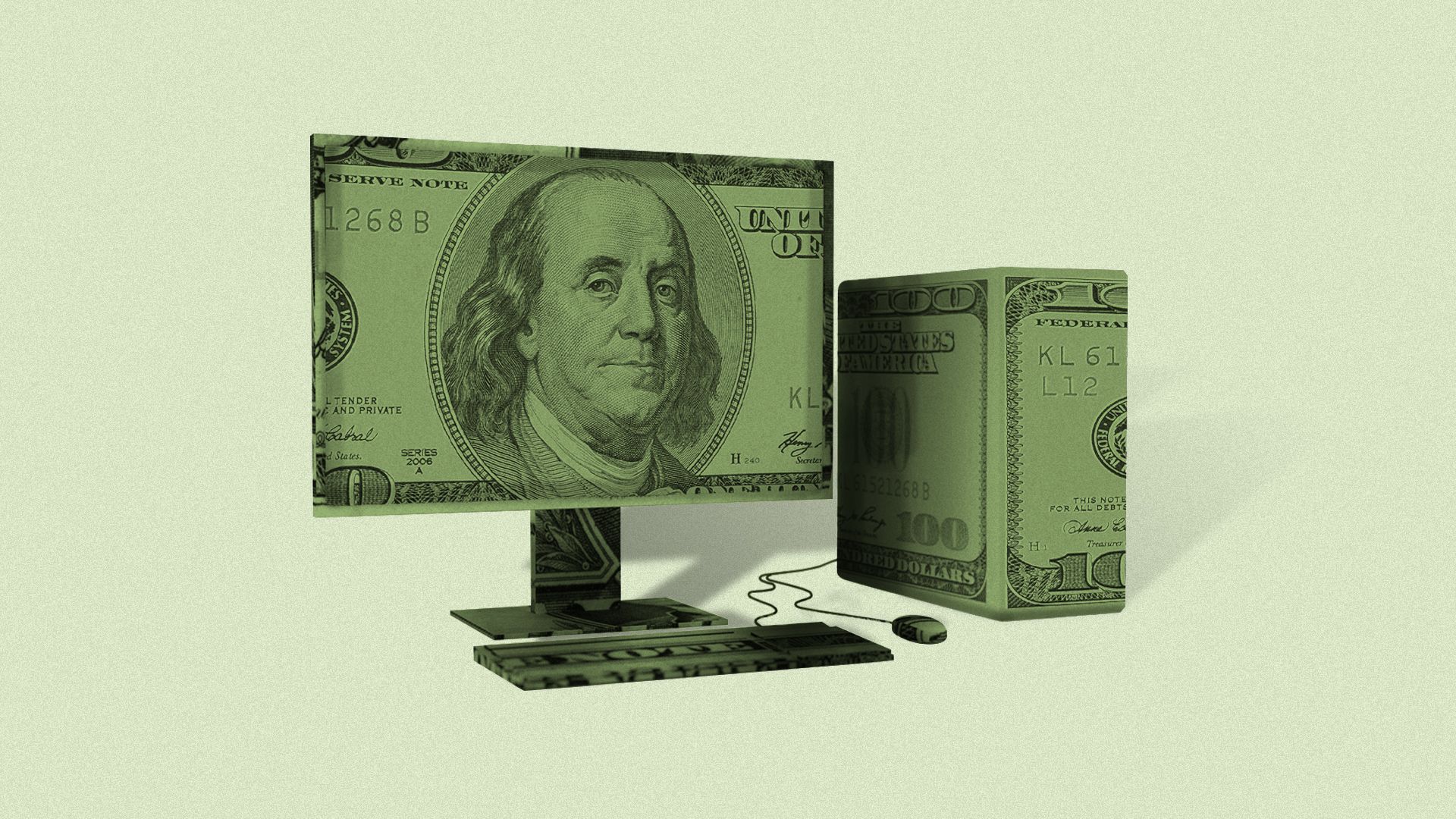| | | | | | | Presented By Mastercard Center for Inclusive Growth | | | | Axios AM Deep Dive | | By Mike Allen ·Nov 30, 2019 | | This Axios AM Deep Dive, ahead of Giving Tuesday, looks at America's homegrown and idiosyncratic system of philanthropy. - Smart Brevity count: 1,492 words — a 5½-minute read.
| | | | | | 1 big thing: Billionaires build new "benevolent aristocracy" |  | | | Illustration: Aïda Amer/Axios | | | | Philanthropists are increasingly looking to steer or supplant government, Felix Salmon writes. - As Mike Bloomberg puts it: "It's philanthropy's job to take risks — and government's job to scale solutions."
- Swiss bank UBS, in its fifth annual report on billionaires, says many "are seeking new ways to engineer far-reaching environmental and social change."
- Within our lifetime, we will see "the reemergence of a benevolent aristocracy," Josef Stadler, UBS's head of ultra-high net worth, tells Forbes.
How it works: Individuals like Bloomberg, Charles Koch and Bill Gates use their philanthropies to advocate for societal changes and interventions that they would like to see enacted by governments. - Often they engage in explicit lobbying, and often that lobbying is successful, both domestically and internationally.
- Older philanthropies may no longer be controlled by their founders, but care just as much about changing global public policy.
- The Ford Foundation, for instance, has focused on combating inequality around the world — something that can only be done if it gets governments on board.
Why it matters: Politicians are accountable to the electorate. Charitable foundations and the billionaires who fund them, on the other hand, are accountable to no one. - Rob Reich, Stanford political scientist and author of "Just Giving," tells Axios: "Foundations are an unaccountable, nontransparent, perpetual, and lavishly tax-advantaged exercise of power."
The bottom line: Insofar as philanthropy has a positive effect, it does so via deeply undemocratic means. Go deeper. |     | | | | | | 2. What Mike Bloomberg's giving says about Mike Bloomberg |  | | | Illustration: Aïda Amer/Axios | | | | To learn what most presidential candidates care about, you have to ask them. But with Mike Bloomberg we can simply look to his philanthropies —which have given away some $8 billion — to get a good idea of his priorities, Felix writes. Bloomberg has pledged to give "nearly all" of his fortune to good causes and uses his philanthropy to spur actions that he thinks governments should be doing, but aren't. - Bloomberg does spend billions on traditional rich-people things. He likes to fund art organizations like the Shed in New York and the Tate in the U.K., and has made enormous gifts to the university he attended (Johns Hopkins).
He also channels money toward major global issues that fall squarely within the traditional government domain, but mainly in much poorer countries than his own. - Tobacco: Bloomberg has put more than $1 billion toward trying to reduce tobacco use. As mayor of New York City, he famously banned smoking in public areas, though most of his charitable funds have been directed at the developing world.
- Climate change: Bloomberg has pledged $500 million to Beyond Carbon, a campaign he initiated that's part of a broader attempt to tackle climate change globally.
- Road safety: Traffic deaths are a major global problem with scientifically tractable solutions, and Bloomberg Philanthropies has donated $259 million over 12 years.
- Cities: The cities we live in can be viewed as complex machines. Bloomberg spends millions to try to help those machines run more smoothly.
The big picture: Most of Bloomberg's philanthropy focuses outside the U.S. He's an outlier, as Americans overwhelmingly prefer to give money to domestic causes. Go deeper. |     | | | | | | 3. How nations stack up |  Reproduced from Johnson, et. al, 2018, " Global Philanthropy Report"; Chart: Axios Visuals The Netherlands has more wealth in charitable foundations than any other nation in the world, in proportion to GDP, according to the Harvard Kennedy School's Global Philanthropy Report, Stef Kight writes. - U.S. philanthropies are the wealthiest, with $890 billion in assets.
- But as a share of GDP, the Netherlands and Switzerland each have substantially more invested in charities than the U.S. or anywhere else.
Go deeper. |     | | | | | | A message from Mastercard Center for Inclusive Growth | | A community's data-driven comeback | | | | | | | For decades, a historic neighborhood in New Orleans was in economic decline. Now, a unique collaboration between data scientists and the local community has helped the area's revival. | | | | | | 4. Helping middle-schoolers travel abroad |  | | | Illustration: Aïda Amer/Axios | | | | Philanthropy tends to center on a small number of affluent donors, but a grassroots movement known as "giving circles" — in which more modest donors pool their resources — has been gaining popularity, Alison Snyder writes. The big picture: Giving circles are still a drop in the philanthropic bucket, but proponents say they open the field to younger and more diverse donors — and broaden the reach of giving. - Members decide by vote or consensus which organizations to fund.
- "This is activism in the world of philanthropy ... and an antidote to other concerns," Dianne Chipps Bailey, a philanthropic strategy executive for Bank of America, tells Axios.
More than 1,000 such groups existed in the U.S. in 2016, compared with 400 in 2006, per a Women's Philanthropy Institute database. - The model resonates with women: Of those groups, about 70% said more than half their members were women.
- Giving circles tend to be hyper-local and to come together around shared identity. (Examples include Asian Women Giving Circle in New York, and Amplifier, a network of circles focused on Jewish values.)
Black Benefactors, a 12-year-old giving circle in Washington, D.C., donates to black-led nonprofits — which tend to be overlooked by the broader philanthropic community. - 40 members donate at least $300 a year; so far, $70,000 has been given away.
- Grants focus on organizations that support local children, youth and families — like $10,000 in 2019 to a group that sends middle-school girls of color on trips abroad, and $10,000 to one that funds math and science enrichment.
Go deeper. |     | | | | | | 5. For space billionaires, their companies are their gift |  | | | Illustration: Aïda Amer/Axios | | | | Billionaires Elon Musk and Jeff Bezos are casting the fortunes they've spent on building new rockets to help humankind escape our home planet as a far greater legacy than funding more terrestrial good deeds, Nicholas Johnston writes. The big picture: They're reframing for-profit businesses — SpaceX and Blue Origin — in philanthropic terms. Musk spent $100 million to get SpaceX off the ground in 2006. - "We're faced with a choice: Which future do you want?" Musk said at the unveiling of SpaceX's Starship in September.
- "Do you want the future where we become a space-faring civilization and are on many worlds and are out there among the stars, or one where we are forever confined to Earth?"
- In comparison, the private charity he started in 2001, the Musk Foundation, gave away $54 million over 15 years to environmental, educational, medical and other causes, per an analysis by The Guardian. (He has also signed the Giving Pledge.)
Bezos has reportedly funneled $1 billion a year into Blue Origin — compared with recent grants of $98.5 million focused on homelessness and education from his year-old philanthropy, the Bezos Day One Fund, that was seeded with $2 billion. Both billionaires believe the only way for humanity to survive as a species is to go to space — to provide an insurance policy against damage to Earth, or allow harmful activities to be moved off-world. Keep in mind: SpaceX brings in billions from government and commercial contracts, and Blue Origin is chasing after those contracts to get its launch business up and running. The bottom line: The Bezos-and-Musk brand of philanthropy says, in effect, that their big contribution to human knowledge and understanding is their space company. |     | | | | | | 6. Tax breaks now, money for charity later |  Data: National Philanthropic Trust; Chart: Axios Visuals Billions of dollars are sitting in tax-free donor-advised funds (DAFs) rather than being distributed directly to charities, according to data from the National Philanthropic Trust, Stef reports. - A DAF "allows donors to make a charitable contribution, receive an immediate tax deduction and then recommend grants from the fund over time," the NPT explains.
- Proponents say DAFs are vital to the future of impact investing — making positive changes particularly in local communities.
The big picture: The amount of money in DAFs keeps growing — 13% of all individual, charitable contributions now go into these funds, up from 4% in 2010. - It's too early to say, but DAFs could get a boost from President Trump's new tax code, allowing philanthropists to take an up-front tax break long before the money makes it to any specific cause.
Between the lines: Critics of DAFs see them as easy tax breaks for the wealthy with no enforcement mechanisms to ensure that money actually goes to charity. Go deeper. |     | | | | | | 7. Silicon Valley's cost-benefit philanthropy |  | | | Illustration: Aïda Amer/Axios | | | | Silicon Valley's new moneyed class has a very different view of philanthropy, often inspired by "effective altruism"— using data and analysis to choose causes and approaches that will yield the most impact, Kia Kokalitcheva writes. - Effective altruism calls for using cost-benefit analysis to back nonprofits that can show the most measurable and demonstrable results.
Why it matters: This brand of philanthropy focuses on large problems — like access to education and issues in the developing world — and can come at the expense of local community needs and more traditional giving. The big picture: The effects of this shift in philanthropy are brutal for some traditional nonprofits. The arts feel neglected — as do groups that help the homeless. - In recent years, less than 10% of donations from Silicon Valley (sans San Francisco) have gone to local nonprofits. And less than half of that has gone to groups like food banks that tackle community needs (instead of, say, hospitals or universities), according to the Giving Code, a 2016 report.
- "They feel solvable," Shannon Farley, co-founder of Fast Forward, an accelerator for tech nonprofits, says of the focus on favorite causes like fighting diseases.
- "We could cure malaria in our lifetime. But you can't fix inequality — especially if you're benefiting from it," Farley says.
Between the lines: Not surprisingly — given that it is Silicon Valley — "impact metrics" are an increasingly important tool for nonprofits as they market themselves to prospective donors. - Some local charity leaders are getting savvy, taking a lesson from the for-profit world even as they compile data about their do-good activities.
Go deeper. |     | | | | | | A message from Mastercard Center for Inclusive Growth | | Unlocking the economic potential of underserved communities | | | | | | | Data-driven insights are critical to help long-neglected communities attract investment. Delve inside the story of how data has given rise to hope in New Orleans. | | | | �� Thanks for reading our Deep Dive. Please invite your friends to sign up for AM and PM. | | | | Axios thanks our partners for supporting our newsletters.
Sponsorship has no influence on editorial content. Axios, 3100 Clarendon Blvd, Suite 1300, Arlington VA 22201 | | | You received this email because you signed up for newsletters from Axios.
Change your preferences or unsubscribe here. | | | Was this email forwarded to you?
Sign up now to get Axios in your inbox. | | | | Follow Axios on social media:    | | | | | |
Comments
Post a Comment